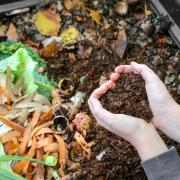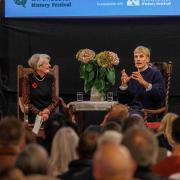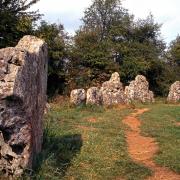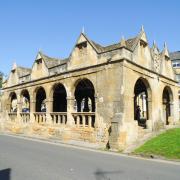Weather events around the world are never far from the headlines – it is well known that on average the planet has warmed by around 1.20C since the Industrial Revolution ¬and the UK Government is committed to achieve net zero greenhouse gas emissions by 2050 as part of efforts to avoid the worst consequences of climate change.
What does this mean for the Cotswolds National Landscape (CNL)? As a protected landscape it faces some tricky balancing acts:
‘Quite often climate change mitigation or climate change adaptation actions can rub up against what [our team at] the Cotswolds National Landscape is legally tasked to do around conserving and enhancing the area’s natural beauty,’ says CNL Chief Executive Andy Parsons. Just one example is potential tension between conserving open landscape views and calls to plant more trees to absorb and store carbon dioxide from the atmosphere.
‘But our landscapes have always changed, and they are going to do so as a result of climate change,’ Andy continues. ‘We have to find a way of playing our full role in climate action whilst also respecting and protecting the landscape as much as possible. We have been tasked by Defra to ensure there is a climate change plan linked to or included within our statutory management plans.’
Updated every five years, CNL’s next management plan, for 2025-2030, is due in just 15 months and the team is accelerating an engagement programme bringing together farmers, land owners, land managers, local businesses, key organisations and individuals, to help inspire and be able to endorse a pathway towards net zero in the Cotswolds.

CARBON BASELINE
At the heart of discussions will be recently published findings from an independent report that CNL commissioned from Small World Consulting (SWC), which set out to provide a picture of current carbon emissions in the Cotswolds: highlighting climate impacts from what residents, visitors and businesses consume, and how land is used.
SWC has undertaken similar work for all National Parks and several Areas of Outstanding Natural Beauty, ensuring a consistent methodology and foundations for working together, Andy says.
You can read the report and a useful ‘layman’s guide’ summary of the headlines on the CNL’s website. Using available data from 2019, the analysis focused on six priority categories:
Energy (eg electricity, heating) accounted for 38% of carbon emissions across the Cotswolds National Landscape; food and drink 24%; other goods and services purchased (clothing, electronics etc) 9%; visitor travel (excluding flights) 20%; land-use / non-carbon dioxide (eg emissions from livestock and fertiliser use) 9%.
Recognising that land management also offers ways to mitigate climate change, for example through sequestration of carbon by trees, hedgerows, grasslands and other healthy soils, it was calculated that the Cotswolds landscape currently absorbs about 8.5% of the estimated emissions from the five sources above.
OPPORTUNITIES TO MAKE A DIFFERENCE
Alongside these baseline statistics, SWC has put forward potential scenarios for reducing or mitigating carbon emissions in order to achieve net zero in the Cotswolds by 2050.
To illustrate the scale of the challenge it says if we only planted trees to offset all the greenhouse gases we emit, the whole of the Cotswolds would be covered in trees by 2050. Of course, no-one is suggesting that but it underlines the need to tackle emissions across a wide range of activities –¬ cutting our use of energy or greenhouse gas emissions from energy production by about 14% a year, for example.
‘When you first read SWC’s report or the layman’s guide we put together, [the challenges] do look daunting,’ Andy says. ‘But we’ve all got opportunities to make a difference, whether at an individual level, organisational level or policy-maker level. We want to bring to light the positive things people can do. It is about making [the challenges] manageable.’
Proposals by SWC include day-to-day things like cutting food waste and repairing and recycling goods rather than throwing them away and replacing them with new. Scaled-up recommendations look at what businesses and landscape managers can do. Visitor travel and land use are two of the trickiest areas to tackle in the Cotswolds:
Around 16 million people a year visit the Cotswolds, with tourism supporting almost 31,000 jobs. One idea put forward by SWC is to encourage longer stays which then reduces the relative carbon footprint of travelling to and from the area per trip.
Farming has shaped the Cotswolds and today accounts for some 86% of land use. ‘Of all the challenges, land use and land management is absolutely the one that we need to get right and understand how we can journey towards net zero,’ Andy says.
Increased adoption of regenerative farming practices is among SWC proposals, though whatever pathways are followed need to be balanced with food production demands and farmers’ livelihoods.

WORKING TOGETHER
Andy is keen to emphasise that the report’s recommendations are put forward independently by SWC. Everything is up for discussion and CNL wants to consult as widely as possible to help to find a general consensus on the ways forward to net zero. New information will always emerge and plans can be adapted accordingly – but inaction is not an option.
Workshops are being held this autumn, inviting farmers, land managers and key organisations such as the NFU to discuss SWC’s report and look at what are workable climate-friendly actions in land use and land management in the Cotswolds. Online workshops involving local businesses and other key stakeholders are being held to discuss ideas for carbon reductions in energy, food and drink, and visitor travel sectors.
Sustainability consultancy 3Keel is helping to organise and run the workshops, and will provide independent post-workshop analyses and outcomes.
‘We hope parish councils will get involved in the debate because they have local knowledge, and we will be following up the workshops by engaging with residents and the wider public on social media, getting diverse opinions and ideas, and it is really important to involve young people,’ Andy says. ‘From that, hopefully, we will be able to identify the journey to net zero, and the types of targets to build into our management plan 2025-2030, with the buy-in of the Cotswolds community.
‘It is not going to be an easy challenge to balance climate action with protecting the Cotswolds’ landscape character, and the pathway to net zero won’t be in a straight line. We will be constantly reviewing the journey and adjusting it as new technology, science and policies come out. The key thing is to start working together on that journey.’
GET INVOLVED
Go to the ‘Net Zero’ page of the Cotswolds National Landscape website to download Creating a Pathway to a Climate-Friendly Cotswolds (a layman’s guide to Small World Consulting’s carbon baseline assessment) as well as the full technical report, cotswoldsaonb.org.uk
Outcomes from autumn workshops and other updates will be posted on the website and you are invited to engage in the climate solutions debate via CNL social media #CotswoldsNationalLandscape @CotswoldsAONB



























